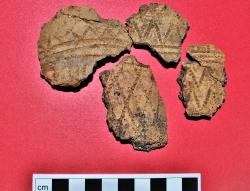Source - http://www.inverness-courier.co.uk/News/Bone-bow-and-arrow-wrist-guard-and-pottery-found-with-Bronze-Age-body-in-Drumnadrochit-03022015.htm?

Some of the decorated shards of the beaker pot found at the site. Picture: AOC Archaeology Group
Drumnadrochit's earliest-known resident, who lived around 4500 years ago, wore a stone guard on his wrist when using a bow and arrow and favoured geometric designs on his kitchenware.
Following the discovery last month of an early Bronze Age burial cist in the village, archaeologists have found shards of pottery and a wrist guard on the same site.
Now, work is ongoing to glean as much information as possible about the finds, and it is even hoped to determine the gender of the skeletal remains – though it is thought the archery equipment may provide a clue.
The cist and artefacts were uncovered during works preparing the site of the NHS Highland’s replacement Drumnadrochit Health Centre.
Heather Cameron, senior project manager with the health board, said: “We are particularly excited to have uncovered the pottery and wrist guard in what appeared to be a second grave next to the first, and I think we will be looking to mount a display on the finds somewhere in the new building when it opens at the end of the year.”
Mary Peteranna, of AOC Archaeology Group, has been working on what she described as “significant” finds for NHS Highland.

The wrist guard which may have been functional or ornamental. Picture: AOC Archaeology Group.
She said: “The shards are of around two-thirds of a beaker pot which will probably have been around 20-30cm high. What makes them particularly interesting is that there is some organic material adhering to the base of the pot, so we may find out something about its contents.
“The shards have a distinctive decoration which may have been made on the clay before firing in a stabbing movement with something like a feather quill.
“The wrist guard is also particularly exciting. It has holes so that it could be tied to the wrist with a leather strap, and may have been ornamental or functional.”
The skeletal remains, which may be of an adult or near adult, comprise of most of a person’s long bones along with part of the skull and a number of teeth. It is hoped to be able to determine scientifically the sex of the person, and perhaps even the cause of death.
The artefacts have been photographed, recorded and removed and will now be undergoing specialist, detailed analysis. A decision will then be taken about what to do with them.
Archaeologists have investigated a 4m x 4m area on the site, which lies just off the A82. NHS Highland said that, with ground clearance work having been completed, it is not planned at this stage to carry out further archaeological work there. However, with more construction work planned on the other side of the main road, where houses and retail units are to be built, further finds have not been ruled out.
The new, £1.5 million health centre is being built on a greenfield site near the existing health centre in Balmacaan Road. It will feature enhanced GP facilities, community services, additional clinical services and social work facilities. It has been designed to accommodate wider use by the general public out of working hours, and will have capacity for future expansion if needed.